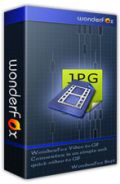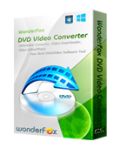毎日 通常購入しなくては使用できないソフトウエアを無料で提供します!

Giveaway of the day — WonderFox Video to Picture Converter 1.1
WonderFox Video to Picture Converter 1.1< のgiveaway は 2014年1月18日
WonderFox Video to Picture Converter は写真をビデオフレームjより抽出することができ、ビデオのフレームを写真として保存することを提供。
好きなビデオのシーンを GIFで保存してソーシャルサイトやコミュニティーサイトでシェアが可能。Video to Picture Converter は好きな部分を抽出できるようアウトプットの早さを調節可能で特殊効果を追加したりサイズの変更も可能。
機能:
- AVI, MP4, MPG, WMV, MKV, MOVなどのビデオフォーマットをサポート;
- JPG, BMP, GIF, TGA, TIF, PNG, PCX, ICO フォーマットをサポート;
- ビデオをアニメgifイメージへ変換;
- 特殊効果追加;
- アウトプットの早さを調節可能;
- サイズ変更
必要なシステム:
Windows NT4/ 2000/ 2003/ XP/ Vista/ 7/ 8; Processor: 1 GHz Intel or AMD CPU; Free Hard Disk Space: 50 MB or more; RAM: 512 MB or above
出版社:
WonderFox Soft Incホームページ:
http://www.videoconverterfactory.com/video-to-picture-converter/ファイルサイズ:
14.6 MB
価格:
$29.90
他の製品

長い変換時間を短縮して映画を見たい方へ最適なツールで WonderFox DVD Video Converterはビデオを変換、DVDへコピーしたりオンラインビデオをダウンロードしたり、DVDやビデオをプレーバック可能。

高画像の HD ビデオは異なったHDタイプがあり、このツールはHDビデオ間を変換。 WonderFox HD Video Converter Factory Pro はHDビデオを簡単の変換。ビデオのサイズ変更も可能で100以上のビデオフォーマットをサポート。

WonderFox Video Watermark はビデオのコピーライト保護に最適で、ビデオにウォーターマークを追加し他から無断で使用されることを阻止。 WonderFox Video Watermark が簡単にテキスト、ロゴ、イメージ、サインをビデオを追加。 50% 割引を GOTDユーザーへ提供(Life-time/3PC)こちらで購入可能

写真やアートワーク、また会社の製品のデモをインターネット上で行う際に、ウォーターマークを追加して他からの無断使用を阻止。 WonderFox Photo Watermark はテキスト、イメージをウォーターマークとして追加、クリック作業で簡単に完了。 50% 割引を GOTDユーザーへ提供 (Life-time/3PC)こちらで購入可能

コメント WonderFox Video to Picture Converter 1.1
Please add a comment explaining the reason behind your vote.
Installed and registered without problems on a win 8.1 64 Bit system.
Difficult to formulate my impression.
This program takes a video and creates pictures. Serial pictures. The output rate can be chosen between a whatever high rate to 0,5 pictures per second. This is simply lousy bad programming, because you can choose 100 pictures per second from a video with a framerate of 24 fps and if you want to take a picture every 10 second, you cannot use the slider, but you must type in by hand.
My second claim is the program window, which cannot be resized. On my big screen I want to resize windows to the point, where I can really see something...
On a "special effect" (called "special efficay")window on the right site you can manipulate the produced images. The programmer must have misunderstood something. He was happy to include a free picture manipulation library, of course. But why the hell should one "emboss", "blur" or "green" the images?
You can choose to take an image from the video by yourself, but it is missing an automatic scene detection.
I choose a frame to take a picture and detected that the video controls are not standard. The "pause" button does not switch between "pause" and "play". Should in my opinion.
I enlarged the picture and choose between the three different interpolation method. Again : Why the hell should I choose "sawtooth"? The programmer thinks in funny picture manipulation.
I'll try a verdict : easy to use, when you really want to take a picture every second from a video or make an animated gif with pictures, taken every 0,5 seconds. And blur these. Why should I do this?
No real use for me. Uninstalled via reboot.
Thanks GOATD and Wonderfox.
Save | Cancel
@ #6 - xpman - I believe you are thinking of VirtualDub. It is free at http://virtualdub.sourceforge.net and it does all this plus more.
Well, not all. As you said, picture format output is limited to just a couple image formats, but it's main function is to be a nice little video editor.
It is limited to avi video, but with the zillions of converters offered here, that should not be a huge drawback.
I tried this on Win8 and it's OK. But the only advantage of this over VD is the many formats it handles.
Save | Cancel
#5: "So I tried it on an HD m2ts file, output as “BEST” – ani gif isn’t that great. Many artifacts.
So I tried .tga frames as they suppose to give best quality … but than I found no good interlaced frames. I can’t find any DE-intelace option .
This is a major drawback of such software"
The problem is the video -- not the software. Most video that you can get your hands on is just not that great when it comes to image quality, but at 24 - 30 fps you don't notice. RE: Interlace & Deinterlace, if the video you have is actually interlaced, you can usually get the best results deinterlacing using various different methods in Avisynth or filters in VirtualDub, though some folks I think have done work in this area using Handbrake -- the idea is you get more total image data shooting interlaced, which you then use Handbrake on to achieve higher quality progressive frames than you could otherwise. That said, if you're going to wind up going back to video once you've processed the frames as still images, you might process the individual fields as 1/2 height stills & reassemble them into interlaced video afterwards. 1 interlaced frame = 2 fields.
* * *
#7: "I believe you are thinking of VirtualDub... It is limited to avi video, but with the zillions of converters offered here, that should not be a huge drawback."
You don't want to convert your video to avi just to disassemble it into individual images -- you'll lose far too much quality. The traditional way you get whatever format of video into VirtualDub is to use Avisynth. After installing Avisynth you write a few lines of scripting in a plain text file you name with an .avs extension -- for something like this there are plenty of examples on-line you can copy/paste. An example would be a single line script:
DirectShowSource("Your Path & Filename Here",The fps For That File Here,video=true)
When you open that .avs file in VirtualDub or whatever program, it will use whatever Direct Show [DS] software you have installed that's available & that can decode that video for playback, say in Windows Media Player. Avisynth will open that file, read the picture data frame by frame, feeding it to VirtualDub as if VirtualDub had opened the video file itself. That skips re-encoding the video & writing it to disk as an avi file, avoiding that quality loss & usually saving quite a bit of time.
If you do decide you need a avi file for whatever reason, Do Not use ffmpeg or anything based on it if at all possible, & that includes the converters that have been on GOTD. Ffmpeg includes and uses Xvid. Xvid is a mp4 video codec that's compatible with old versions of DivX, & was designed to be an alternative to formats like Windows Media [.wmv] for final distribution back before there were better alternatives like AVC. Instead use a [near] lossless format for your avi file(s) -- I use the UT Video codec, but Avid has a nice codec too that's capable of HD that they give away free. What I use, FWIW, is Avisynth -> VirtualDub, having V/Dub write a avi file using UT Video.
Save | Cancel
A number of years ago I had a freeware program (unfortunately forgot its name) that would extract images from video, if memory serves me correctly it would only do it for one type.
Having said that it was very flexible in the way it extracted video, for example every so many frames, a number of equally spaced frames.
I anticipated today's program would work in a similar fashion and that it would do much more for such a high price.
It has none of the above useful features but, as #3 Karl correctly points out, a number of useless features.
I hope someone will offer something similar that is worth having, today's offering is far too limited to be of much use and way overpriced!
Save | Cancel
Installed fine on XPSP3,
So I tried it on an HD m2ts file, output as "BEST" - ani gif isn't that great. Many artifacts.
So I tried .tga frames as they suppose to give best quality ... but than I found no good interlaced frames. I can't find any DE-intelace option .
This is a major drawback of such software
Save | Cancel